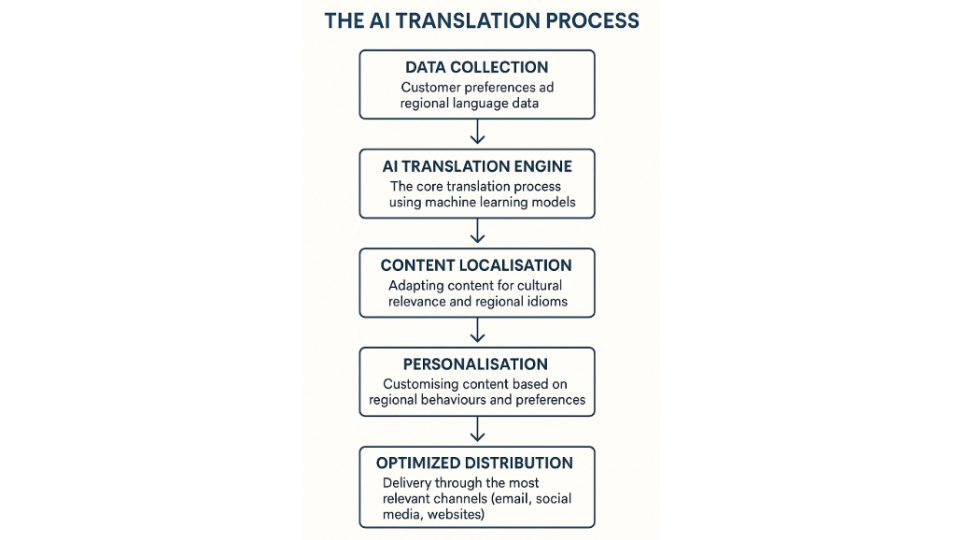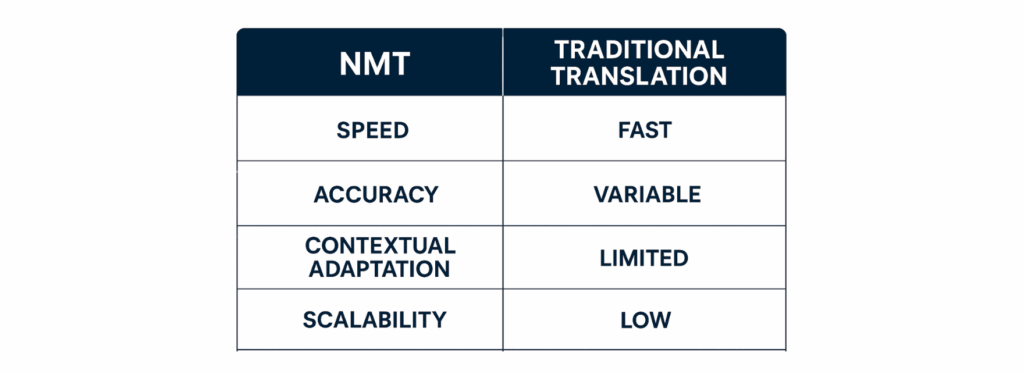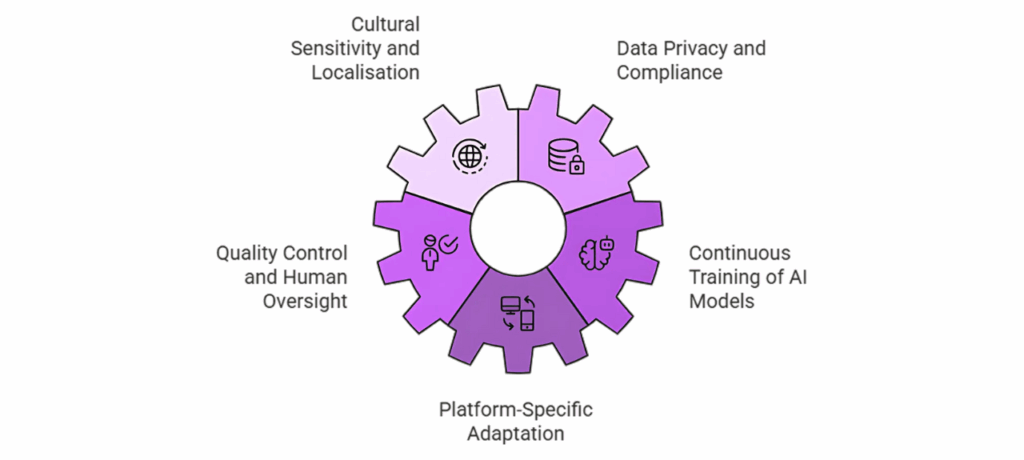In today’s interconnected world, businesses are no longer limited by geography. To truly succeed on a global scale, brands must reach customers in their native languages, creating personal connections that transcend borders.
AI translation tools are revolutionising this process, enabling brands to translate content quickly and accurately while maintaining personalisation. These tools allow brands to speak directly to diverse audiences, ensuring content resonates and engages effectively in multiple languages.
This blog explores how AI translation tools are empowering brands to deliver tailored, multilingual experiences and expand their reach globally.

The Challenge: Traditional Translation vs. AI Translation Tools
The Limitations of Traditional Translation Methods
For years, brands have relied on manual translation to localise their content for global audiences. However, this approach often presents several challenges:
- Time-Consuming: Manual translation is a slow process, often taking weeks for even a single document to be fully translated into multiple languages.
- High Costs: Professional translators charge by the word or project, making translation expensive, especially when scaling across languages.
- Inconsistency: With manual translation, different translators might interpret content in varied ways, leading to inconsistent tone, phrasing, and cultural relevance.
These issues become even more evident when dealing with large-scale campaigns or content that needs to be updated regularly.
AI Translation Tools: A New Era of Speed and Accuracy
AI-powered translation tools address these challenges by automating the process and ensuring consistency across languages. Unlike traditional methods, AI translation tools leverage neural machine translation (NMT) and deep learning algorithms to produce more accurate translations in less time. Here’s how AI tools outperform traditional methods:
- Speed: AI tools can translate large volumes of content in real-time, making them ideal for businesses with frequent content updates or ongoing campaigns.
- Cost-Efficiency: AI translation tools reduce the reliance on human translators, significantly lowering costs and making it possible to scale to multiple languages without breaking the budget.
- Consistency: AI models learn from past translations, ensuring consistent tone, context, and phrasing across all languages, which is vital for maintaining a strong brand identity.
For example, Google Translate and DeepL use machine learning to constantly improve the accuracy and contextual understanding of translations. As AI systems process more data, they become better at grasping subtle language nuances, allowing for more natural-sounding translations and better overall customer experiences.

AI Translation Tools: How They Work and What Sets Them Apart
AI translation tools are powered by neural machine translation (NMT), which uses deep learning algorithms to translate text more efficiently and accurately. Unlike traditional translation methods, AI tools are designed to handle complex language structures, context, and nuances, delivering translations that are not only faster but also more contextually accurate.
How AI Translation Works
At the core of AI translation is deep learning. AI systems are trained on vast datasets containing translations in multiple languages, enabling them to:
- Understand language structure: AI tools can recognise the syntax, grammar, and semantics of different languages, ensuring that the translation reads naturally.
- Adapt to context: AI tools can detect and preserve the meaning behind phrases, making them highly effective for both literal translations and more creative content.
- Improve with usage: AI systems learn from previous translations, refining their understanding and improving over time. This self-learning capability ensures that translations become more accurate and efficient as they are used more frequently.
What Sets AI Translation Tools Apart
AI translation tools offer several advantages over traditional methods:
- Accuracy and Context: Unlike word-for-word translations, AI tools understand context and adapt the message accordingly. This is particularly important for brand messaging, where tone and meaning are key.
- Multilingual Capabilities: AI translation tools support hundreds of languages, allowing businesses to expand their reach globally without the need for multiple translation teams.
- Scalability: AI translation tools can handle large-scale projects, whether it’s translating product descriptions, entire websites, or social media campaigns, making them perfect for businesses targeting multiple regions.
Popular AI Translation Tools
Several AI translation tools have emerged as leaders in the field, each offering unique benefits:
- Google Translate: One of the most widely used tools, offering translations in over 100 languages with continuous improvements in accuracy.
- DeepL: Known for its high-quality translations, especially in European languages, DeepL’s neural network technology delivers nuanced, context-aware translations.
- Amazon Translate: A scalable, cloud-based solution that’s part of the AWS ecosystem, making it ideal for businesses already using AWS for other functions.
These tools enable businesses to deliver personalised, localised content in multiple languages without compromising on tone, context, or customer experience.
The Framework: How AI Translation Tools Personalise Global Content
AI translation tools are revolutionising global content strategies by not only translating text but also adapting it for local audiences. Here’s how AI ensures that the translation process maintains brand voice and cultural relevance, all while keeping the content personalised for different regions.
1. Data Collection and Customer Insights
AI begins by collecting relevant customer data for each region or language. This includes understanding local preferences, cultural nuances, and even slang or colloquialisms. For example:
- Demographic data: Language, region, customer preferences, and browsing behaviours.
- Cultural data: Regional variations in language, tone, or imagery that can affect customer perception.
AI translation tools leverage this data to tailor content, ensuring that the message is not just linguistically accurate but also culturally appropriate.
2. AI Translation Engine
Once customer insights are gathered, the AI translation engine steps in. Here, the system goes beyond simple word-for-word translation by:
- Contextualising content: AI understands phrases, idioms, and context-specific references, ensuring the translation aligns with the region’s linguistic style.
- Adjusting tone and style: The AI adapts the tone of the content (formal or informal, casual or professional) to match the target audience’s expectations.
3. Content Localisation
While translation focuses on converting text, localisation involves adapting the entire message to fit a region’s culture and expectations. AI ensures that:
- Cultural references: Adapt localised content to reflect cultural and regional preferences (e.g., substituting certain products or references that may not be relevant in another country).
- Visual Adaptation: In some cases, AI tools adjust images or graphics based on cultural sensibilities (e.g., using specific colours, symbols, or imagery that resonate with a particular audience).
4. Personalisation Based on Region
AI translation tools use data-driven insights to offer personalised content. This means:
- Offering region-specific promotions, recommendations, and product choices.
- Tailoring email subject lines, CTA buttons, and even message tone to align with customer behaviour in specific regions.
By taking region-specific factors into account, AI helps brands create highly tailored, personalised experiences that resonate with customers on a cultural and emotional level.
5. Optimised Distribution Across Platforms
Finally, AI ensures that personalised content is optimised for distribution on the right channels:
- Emails, social media, mobile apps, and websites are all treated as separate platforms, with content optimised for each.
- AI can recommend the best times to send or post content based on regional engagement trends, increasing the chances of customer interaction.
Real-World Applications: How Brands Use AI Translation Tools for Personalisation
AI-powered translation tools are helping brands achieve global reach while maintaining personalised experiences. By automating translation, content localisation, and distribution, brands can deliver high-quality, tailored content to diverse audiences, increasing engagement and boosting conversions. Below are a few examples of how leading brands are successfully using AI translation tools for global campaigns.
E-commerce: Scaling Personalised Campaigns Globally
E-commerce businesses are rapidly adopting AI translation tools to personalise their content across various markets. AI-powered translation allows brands to tailor product descriptions, customer reviews, and promotional emails, ensuring they resonate with local audiences. By analysing customer preferences, AI can even suggest products based on cultural trends, increasing the likelihood of a purchase.
Example: Amazon uses AI translation tools to localise product pages in over 20 languages. This allows the company to offer region-specific promotions, and personalised recommendations, and maintain a consistent tone across markets, leading to a 15% increase in conversion rates in newly penetrated markets.
Media & Entertainment: Global Content Accessibility
The media and entertainment industries require highly accurate, region-specific content translation to maintain a seamless viewing experience for global audiences. AI translation tools allow content to be localised for subtitles, voiceovers, and even promotional materials, ensuring that the message and tone remain true to the original while adapting for cultural differences.
Example: Netflix uses AI translation tools to localise its vast library of content into over 30 languages. With AI, the platform not only translates the dialogue but also adapts the tone, idioms, and humour, ensuring that the content feels natural for each region. This has been a key factor in Netflix’s expansion into international markets, increasing their subscriber base by 40% in non-English-speaking countries.
Music Streaming: Personalised Music Recommendations
Music streaming platforms use AI translation tools to provide a personalised listening experience for global audiences. AI-driven localisation ensures that music recommendations, playlists, and artist promotions align with regional tastes and preferences. AI tools also help adapt communication, such as notifications and updates, ensuring a consistent message across multiple languages and markets.
Example: Spotify uses AI translation tools to customise recommendations for users in different regions, translating playlists and artist messages into the user’s preferred language. This level of personalisation has helped Spotify increase user engagement by 25% in regions with diverse languages.
Hospitality: Global Travel Personalisation
For global brands in the hospitality industry, such as hotels or airlines, AI translation tools help personalise customer communication, including booking confirmations, service updates, and loyalty programmes. With AI, brands can provide region-specific offers and travel information in the customer’s native language, ensuring a seamless and personalised experience.
Example: Airbnb uses AI translation tools to offer region-specific promotions, descriptions, and customer support. By personalising listings and communication, Airbnb has increased global bookings by 18%, ensuring guests feel understood and valued, no matter where they are from.

Key Benefits of AI Translation Tools
AI translation tools are transforming the way businesses approach global content strategies. These tools offer significant advantages that can enhance operational efficiency, improve customer experience, and drive better outcomes across various industries. Let’s explore the key benefits:
1. Cost-Effectiveness
One of the most immediate benefits of AI translation tools is the reduction in costs. Traditional translation services can be expensive, especially when scaling across languages and regions. AI translation tools eliminate the need for a large team of professional translators, allowing businesses to translate vast amounts of content at a fraction of the cost.
Example: A global fashion retailer used AI translation tools to localise product descriptions, saving 50% on translation costs while expanding its reach to new markets.
2. Speed and Scalability
AI translation tools dramatically improve the speed at which content can be translated and distributed. While manual translation might take weeks, AI tools can deliver accurate translations in real time, enabling businesses to roll out global campaigns or launch new products almost instantly.
Example: Spotify used AI to translate promotional content for their new artist launch, enabling them to go live in multiple languages within 24 hours, compared to the typical 1-week turnaround time of manual translations.
3. Accuracy and Contextual Understanding
AI-powered translation tools go beyond literal translation by analysing the context of the content. This ensures that the translation retains the original message’s tone, intent, and cultural relevance, which is vital for maintaining a consistent brand voice across regions.
Example: Netflix ensures that jokes, slang, and cultural references in their shows are translated to reflect regional humour, providing a seamless viewing experience for subscribers worldwide.
4. Personalisation at Scale
AI translation tools enable personalisation on a global scale. By analysing data from customer preferences, language preferences, and previous behaviours, AI ensures that the translated content aligns with what resonates most with each audience.
Example: Airbnb uses AI to personalise property descriptions and notifications based on the user’s language and location, enhancing the user experience and encouraging more frequent bookings.
5. Consistency Across Platforms
AI translation tools ensure consistent messaging across different platforms—be it social media, websites, or email campaigns. With AI handling translations, businesses can ensure that their messaging remains aligned across all channels, increasing brand recognition and trust.
Example: Amazon used AI translation tools to maintain consistent product messaging and promotional campaigns across their global e-commerce sites, resulting in higher customer satisfaction and improved sales.
6. Continuous Improvement
AI translation tools improve over time by learning from past translations. This continuous feedback loop enhances the accuracy and quality of translations as the system processes more data, ensuring that the translations become more precise and contextually aware.
Critical Considerations When Using AI Translation Tools
While AI translation tools offer many advantages, businesses must consider several critical factors to ensure successful implementation and long-term effectiveness. Below are some of the key considerations that can help ensure that AI translation tools are used responsibly and effectively:

1. Cultural Sensitivity and Localisation
AI translation tools can deliver accurate translations, but they must also account for cultural nuances. Words or phrases that are acceptable in one region may have a different meaning or impact in another. Businesses must ensure that the AI system takes into account local customs, colloquialisms, and regional preferences to avoid cultural misunderstandings or miscommunications.
Action Point: Regularly review AI-generated translations with native speakers or cultural consultants to ensure that the content resonates correctly with the target audience.
2. Data Privacy and Compliance
As AI translation tools process large amounts of customer data, businesses must ensure that they comply with data privacy regulations such as GDPR, CCPA, and other local data protection laws. Any data collected from customers during the translation process should be handled securely, and customers should have control over how their data is used.
Action Point: Choose AI translation tools that are GDPR-compliant and ensure that customer data is anonymised and stored securely.
3. Quality Control and Human Oversight
Although AI translation tools are powerful, they are not perfect. Errors or inaccuracies can occur, especially with complex language or technical content. Human oversight remains crucial to ensure that the translations align with the brand’s voice and messaging. Businesses should have review processes in place to catch any mistakes or inconsistencies before content is published.
Action Point: Implement a hybrid approach by combining AI translation with human proofreaders, especially for critical content like legal documents, product descriptions, and marketing materials.
4. Continuous Training of AI Models
AI translation tools improve with use, but they still require ongoing training and updates to adapt to new trends and linguistic changes. Regular feedback from users and language experts is essential to fine-tune the AI’s accuracy and contextual understanding.
Action Point: Provide continuous feedback to the AI translation tool, allowing it to refine and adapt based on real-world usage and evolving language patterns.
5. Platform-Specific Adaptation
Each platform (e.g., email, social media, mobile apps) has its own set of requirements in terms of tone, content length, and structure. AI translation tools must be adaptable enough to ensure that content is optimised for each platform while still maintaining consistency across channels.
Action Point: Ensure that the AI system can customise content for different platforms, adjusting tone, format, and message length based on the platform-specific guidelines.
Conclusion: The Future of AI Translation in Global Content Marketing
AI translation tools are reshaping how businesses connect with global audiences. By providing accurate, culturally relevant translations at scale, AI enables brands to maintain consistent messaging while engaging customers in their native languages. As these tools continue to evolve, they will only become more efficient, accurate, and context-aware, empowering businesses to expand their global reach with personalised content.
Ready to amplify your global marketing strategy? Harness the power of AI translation tools to ensure your content resonates and converts, no matter where your customers are. Get in touch with us.


